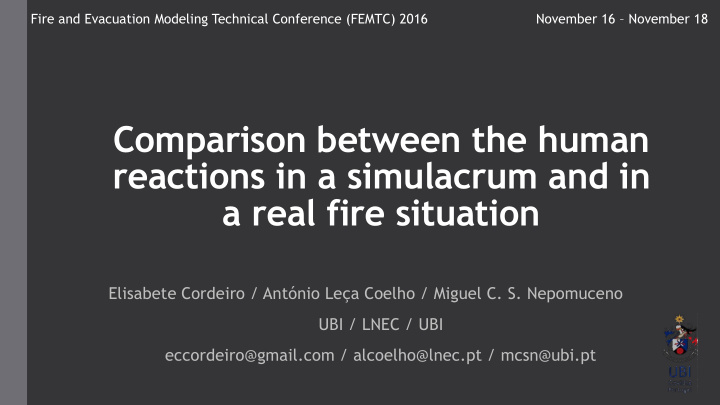



Fire and Evacuation Modeling Technical Conference (FEMTC) 2016 November 16 – November 18 Comparison between the human reactions in a simulacrum and in a real fire situation Elisabete Cordeiro / António Leça Coelho / Miguel C. S. Nepomuceno UBI / LNEC / UBI eccordeiro@gmail.com / alcoelho@lnec.pt / mcsn@ubi.pt
Fire and Evacuation Modeling Technical Conference (FEMTC) 2016 CONTENTS • Introduction • Summary of the Results of the Aware Interpretation Study Time Spent Reaction Comparison of occupant behavior Assessment of the situation Receive indication by someone between Type 1, Type 2 and Type 3 Take Something Task Surveys Way To Leave The Building See Smoke • Conclusion View the fire
Introduction
Fire and Evacuation Modeling Technical Conference (FEMTC) 2016 INTRODUCTION It is necessary to train occupants so in an emergency situation they can react appropriately. These trainings are only possible through exercises/fire drills. To understand if human behavior in fire drills reflects possible human behavior in a real fire situation it is necessary to compare the actions and behavior of the occupants in both situations. TYPE 1 Distributed among people who were involved in a fire The methodology used was 29 based on 3 different surveys. Distributed to the general TYPE 2 population, no selection was made for this distribution 648 People who took part in a fire TYPE 3 drill at two shopping centers 84% were aware 141 of the fire drill.
Aware Summary of the Interpretation Time Spent Reaction Results of the Assessment of the situation Receive indication by someone Study Take Something Task Way To Leave The Comparison of occupant behavior Building between Type 1, Type 2 and Type 3 See Smoke Surveys View the fire
Fire and Evacuation Modeling Technical Conference (FEMTC) 2016 AWARE THAT SOMETHING UNUSUAL IS TAKING PLACE "How did you know that something unusual was happening?” NO ALARM ALARM MESSAGE What mainly caught your attention?
Fire and Evacuation Modeling Technical Conference (FEMTC) 2016 THE ALARM SIGNAL INTERPRETATION
Fire and Evacuation Modeling Technical Conference (FEMTC) 2016 TIME SPENT - BEFORE DECIDING TO LEAVE THE BUILDING “ How much time passed between the moment you became aware that something unusual was happening and the moment you decided to leave the building?”
Fire and Evacuation Modeling Technical Conference (FEMTC) 2016 Reaction to alarm “What did you do once you became aware that something unusual was happening?” Left the Left the Find out location location “What is usually your reaction to the alarm?”
Fire and Evacuation Modeling Technical Conference (FEMTC) 2016 Assessment of the situation “How dangerous do you think the situation was?”
Fire and Evacuation Modeling Technical Conference (FEMTC) 2016 Receive indication by someone to abandon the building “Did you decide to abandon the building because someone told you to?" “Would you leave the building in case someone told you to? " The message indicated to No Security staff Both with leave the building Security staff
Fire and Evacuation Modeling Technical Conference (FEMTC) 2016 TAKE SOMETHING WITH YOU “ When you decided to leave the building, did you take anything with you?" “ Before leaving the building would you try to collect personal belongings ?”
Fire and Evacuation Modeling Technical Conference (FEMTC) 2016 TASK " Before deciding to abandon the building did you perform any of the following tasks (look for family members, warn others, contact the fire brigade, fight the fire, help others, pack your things)? "
Fire and Evacuation Modeling Technical Conference (FEMTC) 2016 TASK " Before deciding to abandon the building did you perform any of the following tasks (look for family members, warn others, contact the fire brigade, fight the fire, help others, pack your things)? "
Fire and Evacuation Modeling Technical Conference (FEMTC) 2016 WAY TO LEAVE THE BUILDING – NORMALLY USED “To leave the building did you use the way you normally use?” “If you were in a building, which path would you use to exit the building?”
Fire and Evacuation Modeling Technical Conference (FEMTC) 2016 WAY TO LEAVE THE BUILDING – USE OF EMERGENCY EXIT “To leave the building did you use an emergency exit?”
Fire and Evacuation Modeling Technical Conference (FEMTC) 2016 FACED WITH SMOKE “I f you were faced with smoke when trying to leave Reaction of the occupants when faced with the smoke the building, what would your reaction be?
Fire and Evacuation Modeling Technical Conference (FEMTC) 2016 View the Fire “If you were leaving the building and Reaction of the occupants when faced with the fire you were faced with the fire. What would your first reaction be?”
Conclusion
Fire and Evacuation Modeling Technical Conference (FEMTC) 2016 Conclusion • Having in mind the conditionality, some of the observed tendencies have been observed as follows: The behavior of occupants can depend on their knowledge of the situation as well as their assessment of it; When the alarm is heard sometimes it is not enough to decide to leave the building; Before leaving the building the occupants perform several tasks, the main tasks are “look for family” or “warn others” as well as “take personal items”; In order to leave the building, occupants tend not always to use the most appropriate way, giving preference to the normal path they used to enter the building; In a fire drill, the behavior of the occupants may be different compared to a real fire situation.
Fire and Evacuation Modeling Technical Conference (FEMTC) 2016 Conclusion Emergency Situation Human Behaviour Building Occupant Characteristics Characteristics
Thank You!
Recommend
More recommend